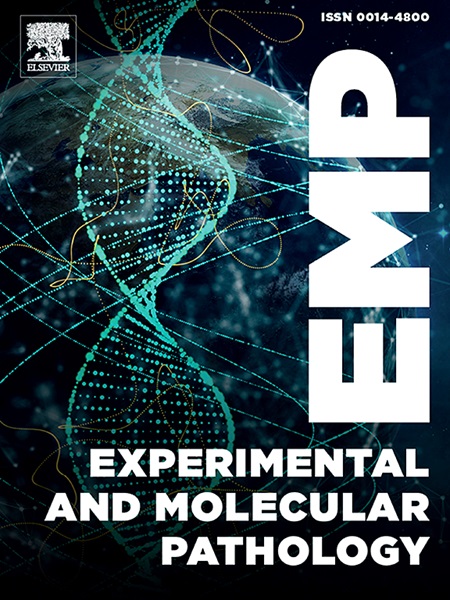胡椒碱和胡椒碱负载的白蛋白纳米颗粒可改善佐剂诱导的大鼠关节炎并降低 IL-17
IF 3.7
4区 医学
Q2 PATHOLOGY
引用次数: 0
摘要
目的类风湿性关节炎(RA)是最常见的慢性、炎症性、自身免疫性疾病之一,主要影响关节。胡椒碱(PIP)是一种存在于黑胡椒中的生物碱,具有抗炎特性,将其用于纳米颗粒等给药系统可能是治疗类风湿性关节炎的一种方法。本研究旨在评估 PIP 可能具有的抗炎和抗关节炎作用,并评估其在白蛋白纳米颗粒中的应用,以此作为治疗佐剂诱导的关节炎(AIA)大鼠的一种可能方法。每两天给 AIA 大鼠腹腔注射 40 毫克 PIP 或 131 毫克 PIP-BSA NPs,直到第 28 天动物被处死。结果 PIP 和 PIP-BSA NPs 显著降低了临床评分,缓解了关节内的炎症。在缓解纤维蛋白沉积和骨膜反应方面,PIP 优于 PIP-BSA,而 PIP-BSA NPs 的骨炎症和侵蚀较轻。结论 PIP 和 PIP-BSA NPs 能有效减轻 AIA 的严重程度并抑制炎症。鉴于 PIP 在改善纤维蛋白沉积和骨膜反应方面的优势,以及 PIP-BSA NPs 在抑制骨炎和骨侵蚀方面的功效,可研究同时使用这两种药物。本文章由计算机程序翻译,如有差异,请以英文原文为准。
Piperine and piperine-loaded albumin nanoparticles ameliorate adjuvant-induced arthritis and reduce IL-17 in rats
Aim
Rheumatoid arthritis (RA) is one of the most common chronic, inflammatory, autoimmune diseases affecting mainly the joints. Piperine (PIP), an alkaloid found in black pepper, has anti-inflammatory properties and its use in drug delivery systems such as nanoparticles might be a treatment for RA. This study aims to evaluate the possible anti-inflammatory and anti-arthritic effects of PIP and its use in albumin nanoparticles as a possible approach for the treatment of Adjuvant-induced arthritis (AIA) rats.
Methods
PIP-loaded Bovine Serum Albumin nanoparticles (PIP-BSA NPs) were prepared using a desolvation method. AIA rats were given intraperitoneal injections of either 40 mg PIP or 131 mg PIP-BSA NPs every two days until day 28 when animals were sacrificed. Clinical score, histopathology, X-ray radiography, and serum levels of pro-inflammatory cytokines such as IL-1β, IL-17, and TNF-α were evaluated.
Results
PIP and PIP-BSA NPs significantly reduced clinical scores, and alleviated inflammation within the joints. PIP was superior to PIP-BSA NPs for the alleviation of fibrin deposition and periosteal reactions while bone inflammation and erosion were less severe in the case of PIP-BSA NPs. Besides, both of the treatments suppressed serum levels of IL-17 in AIA rats (p = 0.003 and p = 0.02; respectively).
Conclusions
PIP and PIP-BSA NPs effectively alleviate the severity of AIA and suppress inflammation. Due to the superiority of PIP in improving fibrin deposition and periosteal reactions and the efficacy of PIP-BSA NPs in suppressing bone inflammation and erosion, their simultaneous use might be investigated.
求助全文
通过发布文献求助,成功后即可免费获取论文全文。
去求助
来源期刊
CiteScore
8.90
自引率
0.00%
发文量
78
审稿时长
11.5 weeks
期刊介绍:
Under new editorial leadership, Experimental and Molecular Pathology presents original articles on disease processes in relation to structural and biochemical alterations in mammalian tissues and fluids and on the application of newer techniques of molecular biology to problems of pathology in humans and other animals. The journal also publishes selected interpretive synthesis reviews by bench level investigators working at the "cutting edge" of contemporary research in pathology. In addition, special thematic issues present original research reports that unravel some of Nature''s most jealously guarded secrets on the pathologic basis of disease.
Research Areas include: Stem cells; Neoangiogenesis; Molecular diagnostics; Polymerase chain reaction; In situ hybridization; DNA sequencing; Cell receptors; Carcinogenesis; Pathobiology of neoplasia; Complex infectious diseases; Transplantation; Cytokines; Flow cytomeric analysis; Inflammation; Cellular injury; Immunology and hypersensitivity; Athersclerosis.

 求助内容:
求助内容: 应助结果提醒方式:
应助结果提醒方式:


